cattle

 I have been very privileged to have had two men that I called “Dad” who were both among the kindest men I have ever met. My father-in-law, Walt Schulenberg became my second “Dad” when I married my husband, Bob Schulenberg in 1975. He was a hardworking man, almost to the point of being a workaholic, but that was common for the times and the bigger families that people had. My in-laws, Walt and Joann had six children, of which my husband was the third child and first boy. In big families, there is, by necessity, a certain amount of joking and teasing. It’s really the only way to make sure the kids aren’t always fighting. Everyone’s kids need to know how to hake a joke. They also, need to know how to tell one in good clean fun. Dad taught them well, as did my parents, so Bob and I were quite compatible in that way, as well as many others, of course.
I have been very privileged to have had two men that I called “Dad” who were both among the kindest men I have ever met. My father-in-law, Walt Schulenberg became my second “Dad” when I married my husband, Bob Schulenberg in 1975. He was a hardworking man, almost to the point of being a workaholic, but that was common for the times and the bigger families that people had. My in-laws, Walt and Joann had six children, of which my husband was the third child and first boy. In big families, there is, by necessity, a certain amount of joking and teasing. It’s really the only way to make sure the kids aren’t always fighting. Everyone’s kids need to know how to hake a joke. They also, need to know how to tell one in good clean fun. Dad taught them well, as did my parents, so Bob and I were quite compatible in that way, as well as many others, of course.
My father-in-law spent most of his childhood living on ranches and learned his work ethic there. When you are 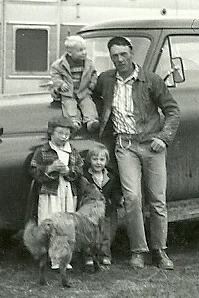
 raising cattle, there is little sleeping in until noon. As with most kids of that era, the workload was shared. The parents couldn’t be expected to take care of everything, especially when there are perfectly healthy kids who can help. He helped with chores around the house, and later with everything from feeding the animals to branding them. Over the years he raised some animals of their own, although not to the grand scale that he had grown up with. I was raised in town, so cows, chickens, rabbits, and the like were a little foreign to me. Nevertheless, if you put your mind to it, you can learn just about anything, and my in-laws were good teachers.
raising cattle, there is little sleeping in until noon. As with most kids of that era, the workload was shared. The parents couldn’t be expected to take care of everything, especially when there are perfectly healthy kids who can help. He helped with chores around the house, and later with everything from feeding the animals to branding them. Over the years he raised some animals of their own, although not to the grand scale that he had grown up with. I was raised in town, so cows, chickens, rabbits, and the like were a little foreign to me. Nevertheless, if you put your mind to it, you can learn just about anything, and my in-laws were good teachers.
Later in his life, my father-in-law moved my mother-in-law and their eldest daughter, Marlyce to town. While he no longer raised animals, he planted a garden in the back yard, from which my mother-in-law canned the vegetables. His also built a hobby barn, really just a tall and fairly large shed, where he could tinker around making different crafts. He made wooden toys and wind spinners. They graced his yard for the rest of his life, 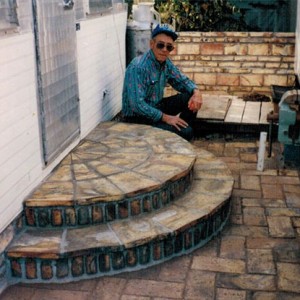
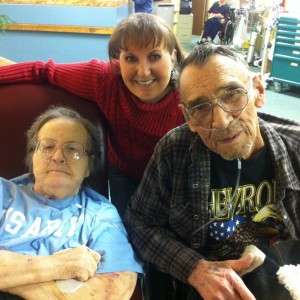 as well as may yards around town. People would see them and want to buy them. He also refurbished lawn chairs, actually making them far more beautiful than they had previously been. He was an accomplished contractor, though mostly just for himself and his family. Nevertheless, he did make so steps for people and a few other things over the years. His was a life well lived, and it makes me sad that he has been gone for eleven years now. Nevertheless, time marches on, and today I find that he did leave us eleven years ago today. I still miss him every day.
as well as may yards around town. People would see them and want to buy them. He also refurbished lawn chairs, actually making them far more beautiful than they had previously been. He was an accomplished contractor, though mostly just for himself and his family. Nevertheless, he did make so steps for people and a few other things over the years. His was a life well lived, and it makes me sad that he has been gone for eleven years now. Nevertheless, time marches on, and today I find that he did leave us eleven years ago today. I still miss him every day.
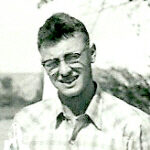
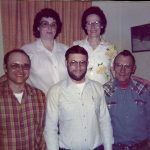 My husband’s uncle, Butch Hein is the youngest of his grandmother, Vina Hein’s five children. Grandma had two children, Marion Kanta and Walt Schulenberg (my husband’s dad) from her first marriage to Andrew Schulenberg; and three children, Esther Hein, Eddie Hein, and Bernard “Butch” Hein, from her second marriage to Walt Hein. Durning her second marriage, the family lived on the ranch that had been owned by Walt’s dad, Christian Hein. Because of that, ranching was practically a part of Butch’s DNA, It was as much a part of his as the air he breathed. While the older children really didn’t want to be ranchers, Butch really did, and since parents usually try to pass their lives’ work down to their kids, Walt had hoped that one of his kids would want to be a rancher. Butch fulfilled the desire his dad had. They worked the ranch together, and when Walt was ready, Butch took over in his dad’s retirement years.
My husband’s uncle, Butch Hein is the youngest of his grandmother, Vina Hein’s five children. Grandma had two children, Marion Kanta and Walt Schulenberg (my husband’s dad) from her first marriage to Andrew Schulenberg; and three children, Esther Hein, Eddie Hein, and Bernard “Butch” Hein, from her second marriage to Walt Hein. Durning her second marriage, the family lived on the ranch that had been owned by Walt’s dad, Christian Hein. Because of that, ranching was practically a part of Butch’s DNA, It was as much a part of his as the air he breathed. While the older children really didn’t want to be ranchers, Butch really did, and since parents usually try to pass their lives’ work down to their kids, Walt had hoped that one of his kids would want to be a rancher. Butch fulfilled the desire his dad had. They worked the ranch together, and when Walt was ready, Butch took over in his dad’s retirement years. 
Butch was quite a bit younger than my father-in-law, Walt Schulenberg, so his nieces and nephews were not that much older than their uncle. Butch was just four years old when he first became an uncle, and by the time he was ten years old he had five nieces and one nephew, and more would follow in quick succession. By the time his siblings were done having children, Butch would have nineteen nieces and nephews. He would also have a son named Scott, and a daughter named Crista, who died in infancy. In reality, Butch didn’t really remember life without nieces and nephews. I’m sure that as a young uncle, or more correctly, a kid who was an uncle, having nieces and nephews gave Butch a lot of “friends” to play with, in addition to his older sister and brother.
There is lots to do on a ranch. In addition to the cattle, there are horses to ride and usually other animals to help out with. Life on a ranch usually includes other types of animals that can be used to food, as well as a garden, which I know Grandma had. What kid do you know that wouldn’t go and have a little “garden raid” when they wanted a snack. Beans and carrots make great fresh snacks, and I’m sure Butch and his 
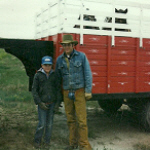 siblings took full advantage of that fact, although probably not to a large extent, because if you eat all the vegetables in the garden, your Mom and Dad would be sure to notice. Besides that, helping on a ranch keeps a kid pretty busy. Most of their “snacks” were in the form of big meals at mealtime. As hard as the work was, Butch thrived on it, and couldn’t wait to work on the ranch with his dad as an adult. Him taking over the ranch was inevitable, and Butch was very happy about that. Today is Butch’s birthday. Happy birthday Butch!! Have a great day!! We love you!!
siblings took full advantage of that fact, although probably not to a large extent, because if you eat all the vegetables in the garden, your Mom and Dad would be sure to notice. Besides that, helping on a ranch keeps a kid pretty busy. Most of their “snacks” were in the form of big meals at mealtime. As hard as the work was, Butch thrived on it, and couldn’t wait to work on the ranch with his dad as an adult. Him taking over the ranch was inevitable, and Butch was very happy about that. Today is Butch’s birthday. Happy birthday Butch!! Have a great day!! We love you!!
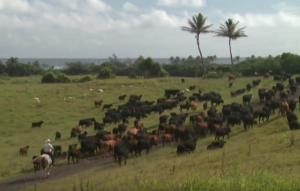 When I think of an island, exotic animals and birds everywhere. I might also think of snakes and other predators in the forests. It occurs to me that these things were not native to the area but were rather brought in by some ship. It makes perfect sense, because there is just no way these animals could migrate to an island. Still, there are animals on islands, like the Hawaiian Islands…in fact there are cattle herds on the Hawaiian Islands and a ranch called TIL Ranching. Maybe that shouldn’t surprise me, but it did.
When I think of an island, exotic animals and birds everywhere. I might also think of snakes and other predators in the forests. It occurs to me that these things were not native to the area but were rather brought in by some ship. It makes perfect sense, because there is just no way these animals could migrate to an island. Still, there are animals on islands, like the Hawaiian Islands…in fact there are cattle herds on the Hawaiian Islands and a ranch called TIL Ranching. Maybe that shouldn’t surprise me, but it did.
TIL Ranching was started when Captain George Vancouver brought cattle to the islands that were under the rule of King Pai’ea Kamehameha. I’m sure most people would think of Vancouver, Canada. Of course, it was named after Captain George Vancouver, a British naval officer, but that is not the only thing he ever did. In 1793, Vancouver gave King Kamehameha five cows from California. He followed that gift with the addition of bull calves. All of these gifts were presented in hopes of cultivating cattle on the Hawaiian Islands. Longhorn cattle from Mexico arrived soon after, and Kamehameha issued Kapu to protect the animals. Kapu refers to the ancient Hawaiian code of conduct of laws and regulations. The Kapu system was universal in lifestyle, gender roles, politics, religion, etc. An offense that was Kapu was often a corporal offense, but also often denoted a threat to spiritual power, or theft of mana. Kapus were strictly enforced. In this case, the Kapu was that the cattle were not to be killed for food. The 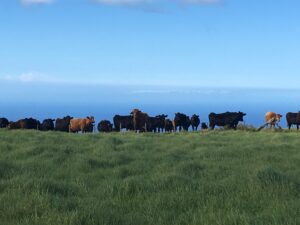 reason was that if the herd was going to thrive, they would need a few years without being butchered, so the herd could grow. When you think about it, that was an amazing gift.
reason was that if the herd was going to thrive, they would need a few years without being butchered, so the herd could grow. When you think about it, that was an amazing gift.
Over the next few decades, there were cattle throughout the Hawaiian Islands. When the herds began to flourish, the Kapu was lifted, and products from the animals became important resources for islanders. When John Palmer Parker married the king’s granddaughter in 1816, he benefited from the increase of cattle, by receiving land and exclusive hunting rights from King Kamehameha. By the 1860s, the cattle were fully domestication and formal ranching was widespread. It’s amazing that from a couple of small gifts, a whole new industry was born.
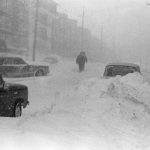
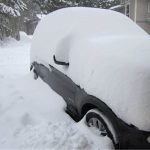 As the United States is in the grip of a fierce snow storm, I am reminded of another snow storm that happened February 21 – 23, 1971. The storm is considered Oklahoma’s extreme storm. This blizzard buried northwestern Oklahoma under as much as three feet of snow, and that doesn’t include the drifting. The town of Buffalo was the hardest hit. They reported 23 inches of snow on the 21st alone, and a state-record snow depth of 36 inches by the morning of the 24th. The northern part of the state was just buried.
As the United States is in the grip of a fierce snow storm, I am reminded of another snow storm that happened February 21 – 23, 1971. The storm is considered Oklahoma’s extreme storm. This blizzard buried northwestern Oklahoma under as much as three feet of snow, and that doesn’t include the drifting. The town of Buffalo was the hardest hit. They reported 23 inches of snow on the 21st alone, and a state-record snow depth of 36 inches by the morning of the 24th. The northern part of the state was just buried.
Oklahoma tends to be a mild weather state, with temperatures in December, January, and February averaging in the 50s. This week is the anniversary of the 1971 blizzard, which was likely the most intense winter storm ever to hit the Sooner State, although the current storm might rival it now. With the current storm, Oklahoma is seeing temperatures averaging -6°. The prior record was in 1909 at 7°. The power company had had to implement rolling blackouts to assure that the power grids don’t fail. I don’t think they have received the amount of snow with the current storm, but the severity is very similar, when you think about it. Anytime a storm is is bad enough to shut things down, especially the power, it is severe.
When the blizzard of 1971 finally ended, 36 inches of snow was measured in Buffalo, which was the state’s record for the highest snowfall total, but the snow drifts measured as high as 20 feet tall. While northwestern Oklahoma was hit very hard, just a short distance to the west in the Oklahoma Panhandle, only light snow fell with Boise City receiving only 3 inches and only 2 inches in Kenton. The 1971 storm put ranchers in a precarious position until C-124s from the Oklahoma Air National Guard dropped 150 tons of hay to stranded Oklahoma cattle. Local cattleman flew along with the aircraft to guide the aircrews to the stranded cattle. The massive loss numbers of 15,000 in livestock accounted for much of the $2 million in damages.
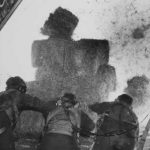
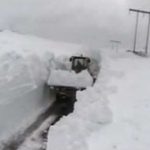 The vicious storm became known as the 84-hour blizzard. It actually occurred across the eastern half of the Texas and Oklahoma Panhandles. The storm his the worst un Oklahoma, but in the region, 8 deaths were reported…7 in Pampa, 1 in the Oklahoma Panhandle. The average drifts were 10 to 20 feet. Storms like these will not likely be soon forgotten, if they are ever forgotten. People are really never prepared for such cold temperatures and so much snow in the southern states. We can try to prepare, but when year after year goes by without such a sever storm, we soon become complacent, until the next one hits us, that is.
The vicious storm became known as the 84-hour blizzard. It actually occurred across the eastern half of the Texas and Oklahoma Panhandles. The storm his the worst un Oklahoma, but in the region, 8 deaths were reported…7 in Pampa, 1 in the Oklahoma Panhandle. The average drifts were 10 to 20 feet. Storms like these will not likely be soon forgotten, if they are ever forgotten. People are really never prepared for such cold temperatures and so much snow in the southern states. We can try to prepare, but when year after year goes by without such a sever storm, we soon become complacent, until the next one hits us, that is.
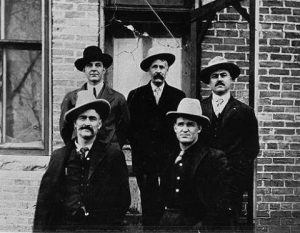 In the early years of Wyoming’s history, there was contention between cattle ranchers and sheep ranchers. The cattlemen thought the land was theirs, and they thought the sheepmen were invading their domain, and they weren’t going to allow it. Cattlemen were first to arrive in the Big Horn Basin, trailing in huge herds of cattle in 1879. They insisted their early arrival established a prior claim to the grass on the government land where their herds grazed. But the law said otherwise. The Cattle and Sheep Wars sprung from this dispute in the Western United States, but they were most common in Texas, Arizona, and the border region of Wyoming and Colorado. The cattlemen thought the sheep destroyed the public grazing lands, which they had to share on a first-come, first-served basis.
In the early years of Wyoming’s history, there was contention between cattle ranchers and sheep ranchers. The cattlemen thought the land was theirs, and they thought the sheepmen were invading their domain, and they weren’t going to allow it. Cattlemen were first to arrive in the Big Horn Basin, trailing in huge herds of cattle in 1879. They insisted their early arrival established a prior claim to the grass on the government land where their herds grazed. But the law said otherwise. The Cattle and Sheep Wars sprung from this dispute in the Western United States, but they were most common in Texas, Arizona, and the border region of Wyoming and Colorado. The cattlemen thought the sheep destroyed the public grazing lands, which they had to share on a first-come, first-served basis.
On April 2, 1909, the range war between the cattlemen and sheepmen in the Ten Sleep, Wyoming area came to a head, when a group of cattlemen decided that they were going to settle this battle once and for all. They headed to Spring Creek seven miles south of Ten Sleep, Wyoming where they knew of a camp. This was to be the last of the sheep raids in the Big Horn Basin. That fateful day, seven cattlemen attacked a sheep camp near  Spring Creek, just south of Ten Sleep, in the southern Big Horn Basin. When the raiders attacked, they killed three men, two of whom the burned to death in their sheep wagon. Then shooting the third man, the decided to kidnap two others. Then they killed the sheep dogs and dozens of sheep and destroyed thousands of dollars of personal property. It was the deadliest sheep raid in Wyoming history. I understand killing in war, but this was murder, and it was horrific!!
Spring Creek, just south of Ten Sleep, in the southern Big Horn Basin. When the raiders attacked, they killed three men, two of whom the burned to death in their sheep wagon. Then shooting the third man, the decided to kidnap two others. Then they killed the sheep dogs and dozens of sheep and destroyed thousands of dollars of personal property. It was the deadliest sheep raid in Wyoming history. I understand killing in war, but this was murder, and it was horrific!!
Wyoming was a territory from July 25, 1868 to July 10, 1890. Early on, there were more cattle ranches than sheep ranches, and the cattlemen felt like they had priority to public lands. Sheep raids began to plague Wyoming since the late 1890s, by which time sheep outnumbered cattle on Wyoming ranges. By 1909, at least six men had been killed, thousands of sheep had been slaughtered, and many thousands of dollars of property destroyed. Nevertheless, there had not been a single conviction for a crime committed during a sheep raid.
It’s really no surprise, given the rising numbers of sheep on the range in those years, that cattlemen were 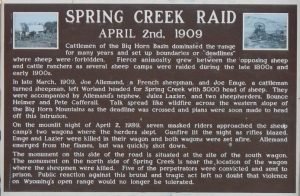 feeling pressured. By 1894 there were 1.7 million sheep in Wyoming and only 675,000 cattle. By 1909, the state’s peak year for sheep, there were more than six million sheep, and only 675,000 cattle. It makes sense that there were tensions, but that did not excuse the men on either side committing murder. Yes, Wyoming was a part of the wild west, and the lawmen were not always readily available, but that did not mean that these men should be able to kill the competition. We are ultimately, civilized people after all, even if we do live in the wild west. After the arrests for the Spring Creek Raid, the cattlemen we reluctant to raid the sheep camps, and with that, a horrific event of the old west passed into history.
feeling pressured. By 1894 there were 1.7 million sheep in Wyoming and only 675,000 cattle. By 1909, the state’s peak year for sheep, there were more than six million sheep, and only 675,000 cattle. It makes sense that there were tensions, but that did not excuse the men on either side committing murder. Yes, Wyoming was a part of the wild west, and the lawmen were not always readily available, but that did not mean that these men should be able to kill the competition. We are ultimately, civilized people after all, even if we do live in the wild west. After the arrests for the Spring Creek Raid, the cattlemen we reluctant to raid the sheep camps, and with that, a horrific event of the old west passed into history.

 Not having had anything to do with the business end of ranching, I find myself fascinated when I look at the pictures of branding, and hear about calving. While others who have been around it for some time, might just think of those things as all in a day’s work, or maybe even as a lot of work. My family were, at least in the years of my lifetime, city dwellers, so until Bob and I got married, I knew very little about country life, other than the little bit of time I spent at a friend’s house, which was not a ranch, and who I was only around during my junior high school years. That said, when I married Bob and we went to visit his grandmother in Montana, I got my first real taste of ranch life. Of course, as a guest and a girl, I didn’t get in on the tough stuff, like calving or branding, but I heard a little bit about it, and in reality, it was quite interesting to me, and I wouldn’t have minded getting to see it.
Not having had anything to do with the business end of ranching, I find myself fascinated when I look at the pictures of branding, and hear about calving. While others who have been around it for some time, might just think of those things as all in a day’s work, or maybe even as a lot of work. My family were, at least in the years of my lifetime, city dwellers, so until Bob and I got married, I knew very little about country life, other than the little bit of time I spent at a friend’s house, which was not a ranch, and who I was only around during my junior high school years. That said, when I married Bob and we went to visit his grandmother in Montana, I got my first real taste of ranch life. Of course, as a guest and a girl, I didn’t get in on the tough stuff, like calving or branding, but I heard a little bit about it, and in reality, it was quite interesting to me, and I wouldn’t have minded getting to see it.
Bob’s grandpa owned the ranch at that time, although his son, Bob’s Uncle Butch is a 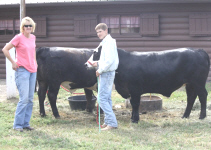 rancher too, and owns not only his own land, but Grandpa’s ranch too, now that Grandpa has passed on. Bob used to spend summers visiting his grandparents when he was a kid, and I’m sure he got in on some of that fun stuff, although I don’t know if he considered it to be fun, but my father-in-law finds the whole process interesting to this day, and often talks to his brother, Butch about how his herd is doing, and how the calving is going. He has told me about his own experiences in calving too, such as the time he had to help a neighbor pull a calf that the mother was having trouble giving birth to, because the calf was coming out wrong. I’m not sure I would want to watch that process, but I guess when it happens, it is all hands on deck, because you can lose both mother and baby, if you don’t get it handled quickly, and even then you can lose them, because, sometimes the calf is just too much for the mother. A sad, but true fact of ranching.
rancher too, and owns not only his own land, but Grandpa’s ranch too, now that Grandpa has passed on. Bob used to spend summers visiting his grandparents when he was a kid, and I’m sure he got in on some of that fun stuff, although I don’t know if he considered it to be fun, but my father-in-law finds the whole process interesting to this day, and often talks to his brother, Butch about how his herd is doing, and how the calving is going. He has told me about his own experiences in calving too, such as the time he had to help a neighbor pull a calf that the mother was having trouble giving birth to, because the calf was coming out wrong. I’m not sure I would want to watch that process, but I guess when it happens, it is all hands on deck, because you can lose both mother and baby, if you don’t get it handled quickly, and even then you can lose them, because, sometimes the calf is just too much for the mother. A sad, but true fact of ranching.
These days, most of the ranching is done by Uncle Butch and his son, Scott, along with Scott’s wife Terri, and their kids, Laura, Carson, and Lindsey. I’m sure some things are 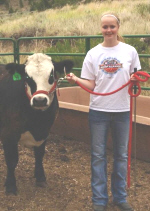
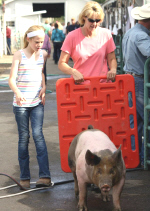 done much differently these days, than back in the early years of Grandpa’s ranching career, but some things don’t change much. Cattle still have to be rounded up, and that still requires horses, riders, and of course, skill…probably another reason I live in the city. Not that I can’t ride, but I’d do best on some old worn out horse that doesn’t move too fast. I find that to be the best way to stay on the horse. From what I’ve see of the Scott and Terri Hein family, they could hold their own with the best of them. I’m sure that being around ranching, your whole life helps with that, but I have a feeling this is in their blood.
done much differently these days, than back in the early years of Grandpa’s ranching career, but some things don’t change much. Cattle still have to be rounded up, and that still requires horses, riders, and of course, skill…probably another reason I live in the city. Not that I can’t ride, but I’d do best on some old worn out horse that doesn’t move too fast. I find that to be the best way to stay on the horse. From what I’ve see of the Scott and Terri Hein family, they could hold their own with the best of them. I’m sure that being around ranching, your whole life helps with that, but I have a feeling this is in their blood.
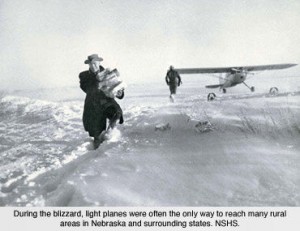
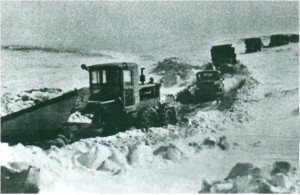 A few days ago, my father-in-law received a phone message from an old family friend. She was calling to wish my mother-in-law a belated happy birthday, and to ask my father-in-law what he remembered about the 1949 blizzard in reference to Colstrip, Montana. Since my father-in-law was in the hospital at the time, I called her back and told her that I would have him call her. Meanwhile, my own interest was peaked about this blizzard, of which I had been totally unaware prior to this call. I got on the Internet and did some searching of my own, and I was quite surprised at what I found.
A few days ago, my father-in-law received a phone message from an old family friend. She was calling to wish my mother-in-law a belated happy birthday, and to ask my father-in-law what he remembered about the 1949 blizzard in reference to Colstrip, Montana. Since my father-in-law was in the hospital at the time, I called her back and told her that I would have him call her. Meanwhile, my own interest was peaked about this blizzard, of which I had been totally unaware prior to this call. I got on the Internet and did some searching of my own, and I was quite surprised at what I found.
The 1949 blizzard began on January 2, 1949, and it was soon to be called the “worst winter ever” by anyone who had the misfortune to go through it. The storm roared across several states, and was actually a series of storms that raged on until February 22, and dumped between 50 and 60 inches of snow, depending on where you were. It put a whole lot of people, especially farmers and ranchers in dire straits. Before long everyone knew that something was going to have to be done. Emergency flights of supplies began bringing everything from food to hay to the desperate people in the area. Snow plows pushed through in an effort to get truckloads of hay into the ranchers. Still, it would not be enough to stop the massive loss of livestock that the coming spring would reveal, not to mention the 235 people across several states who lost their lives. My father-in-law told me that the cows tried to stay above the snow by walking on it as it fell. When the snow got very deep, the cows ended up walking above the trees. Then the weight of their bodies caused them to fall through the snow and into the tree tops, where the were trapped and died of starvation. Some ranchers lost entire herds of cattle, either to falling through the tree tops, or being buried alive. My father-in-law told me that the spring brought a horrible sight. Dead cattle hanging in the trees…everywhere.
Transportation came to a standstill too. Before long trains were unable to move forward, and became buried in the snow, right where they stood. When the tracks were finally cleared, the snow would stand as much as 18 feet high beside them. I’m quite sure it was an eerie sight when the trains finally began to move again, because the piled snow was much higher than the trains, and so prevented any view from the train. Not that it mattered much, because there was nothing but snow to see anyway. I can imagine that if a person was at all claustrophobic, however, the feeling that they would encounter going down that track would be almost more than they could bear.
The spring of 1949, would bring to an end, “worst winter ever” and the beginning of healing for many people. 
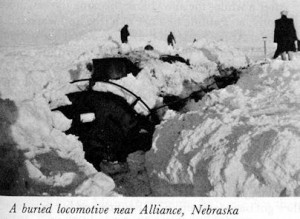 Ranchers would have to begin again. Their herds would have to be rebuilt, and it would take much time and a lot of work. I can imagine that the flooding from all that snow was devastating too. Still, healing would take place too. That spring was also one of beginnings, such as the beginning that is so special to my father-in-law, because on June 6, 1949 he would marry the love of his life, my mother-in-law, and so began their years of marriage…63 years and counting.
Ranchers would have to begin again. Their herds would have to be rebuilt, and it would take much time and a lot of work. I can imagine that the flooding from all that snow was devastating too. Still, healing would take place too. That spring was also one of beginnings, such as the beginning that is so special to my father-in-law, because on June 6, 1949 he would marry the love of his life, my mother-in-law, and so began their years of marriage…63 years and counting.
 Bob and I used to make frequent trips to Montana to visit his grandparents, and sometimes there would be a special occasion in which the whole family would go, or at least a lot of them, for a reunion or some other bigger occasion. Often that would mean some of us staying at the homes of family in Forsyth, while others stayed at the ranch. But no matter where they had everyone stay, at some point, everyone would end up at Grandma’s…the ranch.
Bob and I used to make frequent trips to Montana to visit his grandparents, and sometimes there would be a special occasion in which the whole family would go, or at least a lot of them, for a reunion or some other bigger occasion. Often that would mean some of us staying at the homes of family in Forsyth, while others stayed at the ranch. But no matter where they had everyone stay, at some point, everyone would end up at Grandma’s…the ranch.
The times spent out at Grandma’s always meant big, delicious meals…all home cooked and fresh from their own cattle and garden. Everything tasted so much better there. The cream in the coffee is like nothing you have ever had, unless you got it right from the cow. It was not that tasteless stuff you get at the store, but rather, rich, creamy, thick cream that you had to spoon into your coffee. I’m partial to cream in my coffee, but I have never found anything to compare to that real cream. It just tastes heavenly. The Strawberry-Rhubarb jam that Grandma made from fruit grown in her garden. The beef that Butch raised on the ranch, and eggs right from the chickens. My goodness, I can still taste those things in my memories.
Then, ultimately, after dinner, while the women cleaned up the dishes and kitchen, the men would retire to the front yard, for a meeting of the minds. They would talk about the ranching business, and whether or not they would get a good price for their cattle that year. They would talk about how the mining business was going, since Uncle Eddie and my father-in-law both worked in mines. They might talk about the rain, or maybe the lack thereof, depending on the year, because the life blood of a rancher is the rain. They have to have it if at all possible. These were men who knew what they were talking about. They had watched the trends and made careful decisions based on what they knew of the business they were in.
It was always such a heart-warming thing to watch this father and his sons and step-son talking things out together…each one giving their input while the others listened intently, gleaning every bit of wisdom that the others had to give, and tucking it away in the innermost recesses of their minds, knowing that some day the information stored there would come in handy. These men knew their businesses and had the wisdom of many years behind them. And the memory of those little meetings warms my heart, and I wish with all my heart that those meetings were not just a memory, but since Grandpa has gone home to Heaven, that is what they must sadly remain. Memories of a different time and place.

